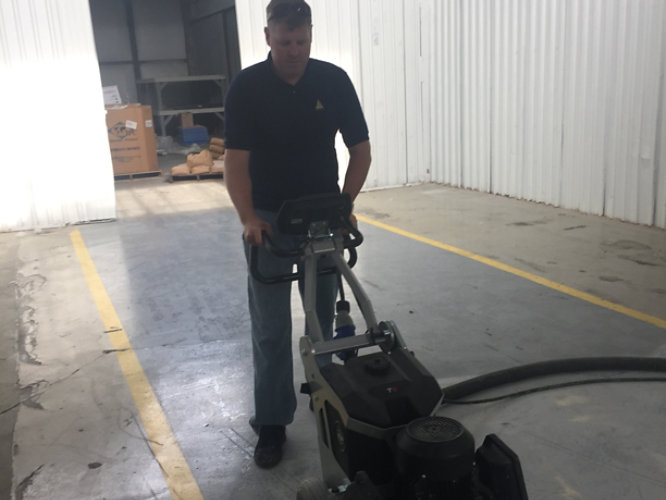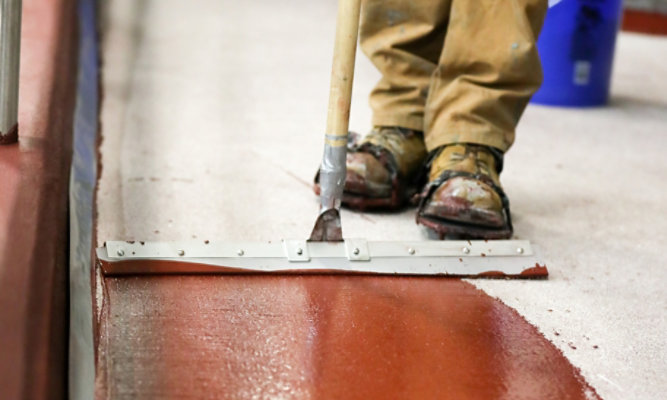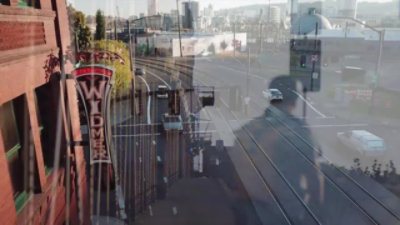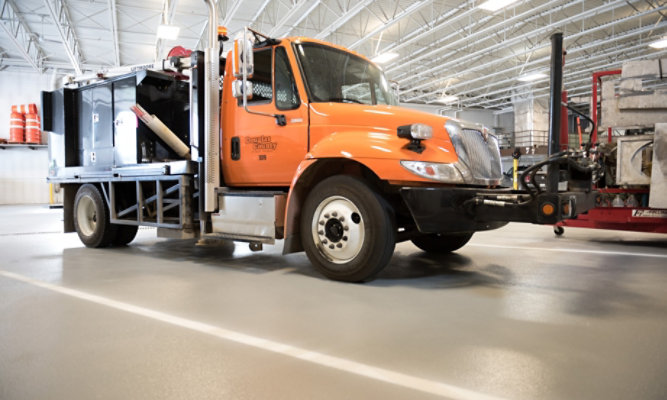Acid Etching Is No Longer Recommended as a Concrete Prep Method
The longevity of a coating partly depends on how well it adheres to the surface of the concrete. The best adhesion requires a clean floor, free of laitance and contaminants.
Laitance is a weak, milky accumulation of fine particles of cement dust, lime and sand fines on the surface of fresh concrete, usually caused by an excess of water bleeding to the surface.
Learn More or Get a Free Flooring Evaluation

What is “Acid Etching Concrete”?
Acid etching is the process of applying hydrochloric/muriatic or buffered phosphoric acid to a slab, then rinsing it off with water. For many years, it was a standard method of concrete preparation used by nearly all industrial, commercial and institutional floor coating installers, depending on the floor size and system to be installed.
How to Acid Etch Concrete: The Basics
Acid etching a concrete floor is typically a 6-step process:
- Prepare, clean, and degrease concrete.
- Hose down or dampen the entire area.
- Use a sprayer or watering container to distribute the acid, scrubbing in as needed.
- Wait for the acid to react with the slab surface.
- Rinse the floor thoroughly, squeegee away puddles, allow floor to dry.
- Apply sealant or epoxy to treat concrete after etching.
Acid Etching Results Are Inconsistent
Acid etching removes laitance, but cannot remove curing compounds or many of the contaminants found in industrial settings, such as oily deposits and water-insoluble materials, any of which can interfere with the adhesion of a coating.
Additionally, because every slab is different, the results can be unpredictable and unreliable, even when the process is done by experienced professionals. The surface can end up uneven, over-etched, or under-etched.
Acid Etching Concrete Results in Only Minimal Profile
Concrete Surface Profile, or CSP, as defined by the International Concrete Repair Institute (ICRI), is a standardized measure for the ‘roughness’ of a given concrete surface. This can range from CSP-1 (smoothest) to CSP-10 (roughest). The thicker the coating system, the higher the required CSP number.
Acid etching tends to produce a CSP-1 to CSP-2 profile, which is suitable for only for very thin systems, such as the low solids, solvent-based coatings of the past. Today’s ultra-high solids and solvent-free industrial, commercial and institutional resinous flooring systems tend to be much thicker, requiring CSP-3 to CSP-9 for best bond and performance; this essentially renders acid etching obsolete. Contractors look to mechanical concrete preparation, such as diamond grinding, shot-blasting and scabbling to create the higher CSPs needed.
Acid Etching Can Damage the Slab
The chemical reaction that occurs when an acid solution is applied to concrete is difficult to accurately predict and control. When applied to the surface, over-etching can easily occur, often making the surface more porous. When the acid is finally rinsed from the surface, the water can more easily enter the porous slab, resulting in potential corrosion of metal rebar and eventual weakening of the entire slab structure.
What Does Etching Concrete Do to Humans and the Environment?
It is not surprising that any physical contact with certain acids can cause chemical burns or other injuries. Lesser known, however, is that even inhaling the fumes from concentrated muriatic acid is extremely dangerous, because it can turn the moisture in the windpipe and lungs into a virtual acid solution. Even with safety equipment, the risks remain significant.
Clean rinse water is introduced to the floor after the etching reaction is completed. This neutralizes the acid solution to a certain degree, provided the rinsing is done correctly. Nevertheless, many local and federal agencies have imposed restrictions on washing the solution (“neutralized” or not) down the floor drain, due to the risk posed to waterways and the environment as a whole.
Acid Etching Can Add Time and Cost to a Project
Regulations for warehousing and shipping high concentration acids involves multiple safety measures and extensive paperwork, thus increasing cost on etching products.
Finally, acid etching introduces water to the concrete, which is best avoided with many of today’s zero VOC and ultra-high solids coatings. Once the substrate is saturated, the contractor must then decide to either wait any number of days for the slab to completely dry or choose a moisture tolerant primer that may add cost to the project. Prepping via mechanical means, rather than acid etching, can be much faster and far more economical.
Our Network of Technical Experts
Our mission is to give you the best possible solution to meet your facility needs. Our team of experts understands the ins and outs of concrete preparation and its effects on the life of your resinous flooring system, and will help ensure you receive optimal flooring value.
Discover More
Industry Expertise and Innovation
See how we help customers find customized solutions for their project and application challenges.
System Lookup
Find out more about our innovative floor systems for a variety of industries.
FIND A SYSTEM

